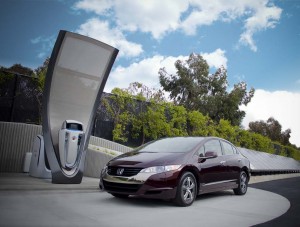It was the first to launch a battery-powered vehicle in the U.S. market, but Honda Motor Co. has been surprisingly reluctant – until now – to embrace the evolving electrification of the auto industry.
While its competitors have pushed into more advanced hybrids, plug-ins, extended-range electric vehicles and pure battery-electric vehicles, or BEVs, Honda has stuck with the “mild” hybrid technology it first introduced a decade ago.
But that’s about to change, the Japanese maker says. It is getting ready an array of battery vehicles that will cover a gamut of applications, says the maker’s CEO, declaring the move “our highest management priority.”
But will Honda be able to regain the lead it briefly held in the green automotive sector with the launch of its first-generation Insight, a 2-seat hybrid? Recent offerings, including a new, 4-door version of the Insight, have fared poorly in the U.S. market, despite growing demand for battery-based vehicles.
“Our highest management priority is to establish a corporate structure that ensures a profit while we develop and commercialize advanced environmental technologies,” says Honda President and CEO Takanobu Ito.
Ito took command of the maker last year from Takeo Fukui, who was reportedly reluctant to invest in technology that he felt wouldn’t earn a profit for some time. Indeed, there are many who believe that the push into electric propulsion is premature without hefty government incentives – and technological breakthroughs that can both reduce the cost and improve the power and range of today’s batteries.
But Ito has approved a range of new battery-based programs, including the tryout of a new battery, set to launch in California later this year. If it proves successful, the maker says it will begin retail sales of the vehicle in 2012.
About the same time, Honda hopes to launch a new plug-in hybrid drivetrain that can be used on some of its midsize and larger vehicles. They would also be offered in the U.S., though a gas-electric version of the subcompact Fit will, at least initially, be limited to the Japanese home market. (See Two More Hybrids Coming from Honda )
Meanwhile, the larger Honda Civic will soon get an upgrade from a nickel-metal hydride to lithium-ion battery.
That in itself is a significant move. Since the Insight made its initial debut in Japan, a dozen years ago, Honda has been wedded to its Integrated Motor Assist, or IMA Hybrid System. Though reasonably low cost, it is also limited in capabilities. Unlike the Hybrid Synergy Drive used on the Toyota Prius, and a similar drive system used by Ford on vehicles like the Fusion Hybrid, the Honda IMA cannot operate on battery power alone. It can only provide a boost of power, say, during hard acceleration.
So, an entirely new system is being developed for the Honda plug-ins.
That will put it behind key competitors including General Motors, which will launch its Chevrolet Volt extended-range electric vehicle later this year, and Nissan, whose Leaf battery car also make a late 2010 debut. Toyota is readying a plug-in version of the Prius to challenge Volt, while Ford is readying BEV versions of the Transit Connect van and Focus subcompact, along with three plug-ins.
Honda still has a lead position when it comes to hydrogen technology, however. It is already leasing its fuel cell-powered FCX sedan in parts of California.
And the Japanese maker says it will jump into the electric motorcycle market, as well, by the end of the year.
Industry leaders are asking the Obama Administration to look at ways to bump up demand for plug-in hybrids and more advanced battery vehicles, something the White House hopes to have in widespread use by mid-decade.


